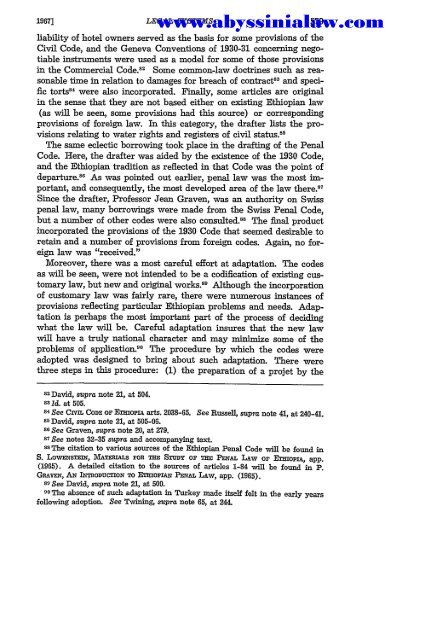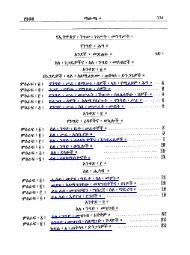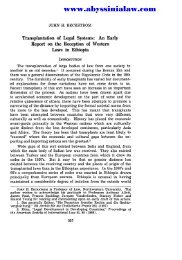Create successful ePaper yourself
Turn your PDF publications into a flip-book with our unique Google optimized e-Paper software.
19671 LEGAL SYSTEMS<br />
liability of hotel owners served as the basis for some provisions of the<br />
Civil Code, and the Geneva Conventions of 1930-31 concerning negotiable<br />
instruments were used as a model for some of those provisions<br />
in the Commercial Code. 82 Some common-law doctrines such as reasonable<br />
time in relation to damages for breach of contract83 and specific<br />
torts84 were also incorporated. Finally, some articles are original<br />
in the sense that they are not based either on existing Ethiopian law<br />
(as will be seen, some provisions had this source) or corresponding<br />
provisions of foreign law. In this category, the drafter lists the pro-<br />
8 5<br />
visions relating to water rights and registers of civil status.<br />
The same eclectic borrowing took place in the drafting of the Penal<br />
Code. Here, the drafter was aided by the existence of the 1930 Code,<br />
and the Ethiopian tradition as reflected in that Code was the point of<br />
departure."8 As was pointed out earlier, penal law was the most important,<br />
and consequently, the most developed area of the law there. 87<br />
Since the drafter, Professor Jean Graven, was an authority on Swiss<br />
penal law, many borrowings were made from the Swiss Penal Code,<br />
but a number of other codes were also consulted. 8 The final product<br />
incorporated the provisions of the 1930 Code that seemed desirable to<br />
retain and a number of provisions from foreign codes. Again, no foreign<br />
law was "received."<br />
Moreover, there was a most careful effort at adaptation. The codes<br />
as will be seen, were not intended to be a codification of existing customary<br />
law, but new and original works. 8 9 Although the incorporation<br />
of customary law was fairly rare, there were numerous instances of<br />
provisions reflecting particular Ethiopian problems and needs. Adaptation<br />
is perhaps the most important part of the process of deciding<br />
what the law will be. Careful adaptation insures that the new law<br />
will have a truly national character and may minimize some of the<br />
problems of application. 0 The procedure by which the codes were<br />
adopted was designed to bring about such adaptation. There were<br />
three steps in this procedure: (1) the preparation of a projet by the<br />
82 David, supra note 21, at 504.<br />
83 Id. at 505.<br />
84 See CIvm CODE OF ETmIopm. arts. 2038-65. See Russell, supra note 41, at 240-41.<br />
85 David, supra note 21, at 505-06.<br />
8 6See Graven, supra note 20, at 279.<br />
87 See notes 32-35 supra and accompanying text.<br />
88 The citation to various sources of the Ethiopian Penal Code will be found in<br />
S. LowENsTEI, MAITmALS FOR THE STUDY OF THE PENAL LAW OF ETropIA, app.<br />
(1965). A detailed citation to the sources of articles 1-84 will be found in P.<br />
GRAVEN, AN INTRODUcTION TO ETmoPIAN PENAL LAW, app. (1965).<br />
89 See David, supra note 21, at 500.<br />
90 The absence of such adaptation in Turkey made itself felt in the early years<br />
following adoption. See Twining, supra note 65, at 244.<br />
www.abyssinialaw.com





